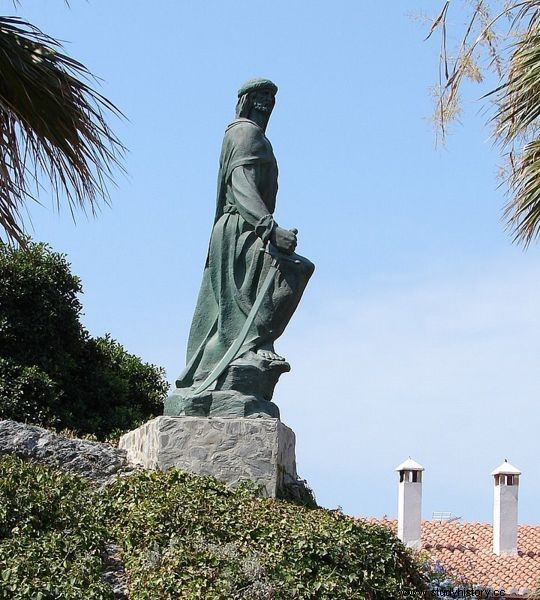Abd al-Rahman ibn Mawiya ibn Hisham (ibn means "son of") was born in Damascus in 731, the son of Prince Muawiya and a North African Berber concubine. It belongs to the Umayyad family.

The Umayyad center of power and seat of the caliphate was Syria, and its court was in Damascus. The dynasty carried out a great expansion of the territories under Muslim Arab rule, they controlled the current Arabia, Iraq, Iran, Palestine, Israel, Syria and Jordan, later they extended to the West to the Maghreb and the Iberian Peninsula and to the East to India and Pakistan. The Umayyad caliph, who holds political and religious power, spread Islam throughout his conquests, but did not impose it by force, allowing the conquered to continue professing their religion, in exchange for heavy tributes, or to become clients (mawali) of the Arabs. This, together with the oppression of rival clans and the distribution of all positions of power and spoils among the Umayyads, leads in 749 to a revolt of the Hashimids (radical and staunch followers of Islam) led by Abh Allah. In the year 750 the revolt reaches Damascus with the purpose of exterminating the Umayyad family. They are persecuted and executed, they even desecrate the tombs of ancient caliphs. The current caliph, Marwan II, is beheaded in Damascus, but the old caliph Hisham, grandfather of Abd al-Rahman, still has time to get his grandson and the slave Badr out of the palace and put them to safety.
Abh Allan moves the capital to Baghdad and adopts the name Abh al-Abbas and his followers the Abbasids (abbasis).
Abd al-Rahman and Badr (who will always remain with him) with the help of the clients of the Umayyads flee to Palestine and from there to North Africa. He takes refuge in the Nafza Berber tribe (near Ceuta) where his mother is from. From there he begins to take shape the revenge of the last Umayyad, he knows that in al-Andalus the waters are troubled. He sent Badr to the peninsula to make contact with the Syrians, clients of the Umayyads, the Yemenis confronted with Yussuf, dependent emir of Baghdad, and with the Berbers, quartered in the poorest and most problematic areas. In August 755, the wandering prince decided to cross the strait and landed in Nerja (Málaga). While preparing the army, Abd al-Rahman enters into negotiations with Yussuf. In May 756, after taking Seville, he decides to leave for Córdoba, the capital of the emirate, to confront Yussuf. Victory goes to the side of the prince's followers, even Yussuf is captured. He spares his life so that he can go to Baghdad and tell the caliph that al-Andalus is Umayyad (he will regret it later, since Yussuf will lead revolts against him). Everything seems to be going well until a group of Yemenis decide to enter Córdoba to loot it and collect loot. Abd al-Rhaman captures them and executes them as a lesson; he does not want to antagonize the Andalusians.
Captured Córdoba and proclaimed himself independent emir as Abd al-Rahman I, prince of the believers. He eliminated the Abbasids of Baghdad from the prayers and minted his own currency.
Al-Andalus begins to shine with its own light, independent of the Abbasids of Baghdad. It is administratively organized in seven provinces, supported by the hachib (prime minister) and the viziers (ministers). The qadis were in charge of the cities and the Koranic council was responsible for religious issues and the integration of the different ethnic groups of al-Andalus (Arabs, Berbers, Muladis, Mozarabs, Jews).
He had to face several revolts, Yemeni and Berber, many of them plotted and directed from Baghdad. He relied on an army of mercenaries who directly obeyed the emir, so that no tribe could control him. In 778 Sulayman, governor of Zaragoza, rebelled against Abd al-Rahman I and asked Charlemagne, King of the Franks, for help. did not deliver it. On his way back, his rearguard was massacred by the Vascones and the emir's troops at Roncesvalles (Cantar de Roldán). The emir took Zaragoza and Charlemagne had to settle for the creation of the Hispanic March (Catalonia and northern Aragon) to curb Muslim power.
The Muslims had used half of the Visigoth Basilica of San Vicente as the main mosque, but since it was too small, the emir bought the part that corresponded to them from the Christians, paying them one hundred thousand dinars and authorizing them, in compensation, to build new churches. In 785 the construction of the aljama mosque of Córdoba (the jewel in the Andalusian crown) began. He also built a palace on the outskirts of Córdoba similar to the one in Damascus and gave it the same name, al-Rusafa, where at the end of his days he was confined.
His last important decision before he died (in 788) was to choose his second son Hisham as heir, to the detriment of his first-born Sulayman, since he considered that Hisham was the one who could ensure the maintenance of the emirate.
We can add little to his last days, only that he became very sullen and despotic (he even expelled his faithful friend Badr from Córdoba).

Source:Passages of History and The Southern Crusade- Juan Antonio Cebrián, The Córdoba of the Umayyads – Antonio Muñoz Molina, History of Muslim Spain – Anwar Chejne and Spain under the Crescent Moon – Angus Macnab.

